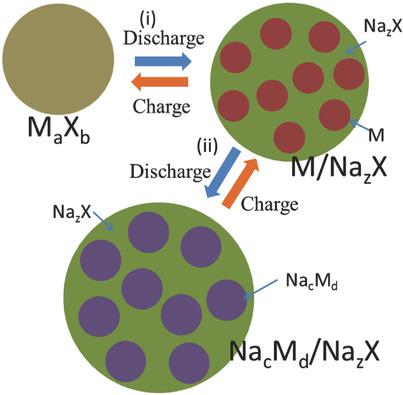Our official English website, www.x-mol.net, welcomes your feedback! (Note: you will need to create a separate account there.)
The State and Challenges of Anode Materials Based on Conversion Reactions for Sodium Storage
Small ( IF 13.3 ) Pub Date : 2018-03-24 , DOI: 10.1002/smll.201703671 Chao Wu 1 , Shi-Xue Dou 1 , Yan Yu 2
Small ( IF 13.3 ) Pub Date : 2018-03-24 , DOI: 10.1002/smll.201703671 Chao Wu 1 , Shi-Xue Dou 1 , Yan Yu 2
Affiliation

|
Sodium‐ion batteries (SIBs) have huge potential for applications in large‐scale energy storage systems due to their low cost and abundant sources. It is essential to develop new electrode materials for SIBs with high performance in terms of energy density, cycle life, and cost. Metal binary compounds that operate through conversion reactions hold promise as advanced anode materials for sodium storage. This Review highlights the storage mechanisms and advantages of conversion‐type anode materials and summarizes their recent development. Although conversion‐type anode materials have high theoretical capacities and abundant varieties, they suffer from multiple challenging obstacles to realize commercial applications, such as low reversible capacity, large voltage hysteresis, low initial coulombic efficiency, large volume changes, and low cycling stability. These key challenges are analyzed in this Review, together with emerging strategies to overcome them, including nanostructure and surface engineering, electrolyte optimization, and battery configuration designs. This Review provides pertinent insights into the prospects and challenges for conversion‐type anode materials, and will inspire their further study.
中文翻译:

基于转化反应的钠存储阳极材料的现状与挑战
钠离子电池(SIB)成本低廉且来源丰富,因此在大型储能系统中具有巨大的应用潜力。就能量密度,循环寿命和成本而言,开发用于SIB的新型电极材料至关重要。通过转化反应运行的金属二元化合物有望作为钠存储的高级阳极材料。这篇综述重点介绍了转化型阳极材料的储存机理和优势,并总结了它们的最新发展。尽管转化型阳极材料具有较高的理论容量和丰富的品种,但它们在实现商业应用方面仍面临许多挑战,例如可逆容量低,电压滞后大,初始库伦效率低,体积变化大,和低的循环稳定性。本文将分析这些关键挑战,以及克服这些挑战的新兴策略,包括纳米结构和表面工程,电解质优化和电池配置设计。该评论提供了有关转化型阳极材料的前景和挑战的相关见解,并将激发他们的进一步研究。
更新日期:2018-03-24
中文翻译:

基于转化反应的钠存储阳极材料的现状与挑战
钠离子电池(SIB)成本低廉且来源丰富,因此在大型储能系统中具有巨大的应用潜力。就能量密度,循环寿命和成本而言,开发用于SIB的新型电极材料至关重要。通过转化反应运行的金属二元化合物有望作为钠存储的高级阳极材料。这篇综述重点介绍了转化型阳极材料的储存机理和优势,并总结了它们的最新发展。尽管转化型阳极材料具有较高的理论容量和丰富的品种,但它们在实现商业应用方面仍面临许多挑战,例如可逆容量低,电压滞后大,初始库伦效率低,体积变化大,和低的循环稳定性。本文将分析这些关键挑战,以及克服这些挑战的新兴策略,包括纳米结构和表面工程,电解质优化和电池配置设计。该评论提供了有关转化型阳极材料的前景和挑战的相关见解,并将激发他们的进一步研究。



























 京公网安备 11010802027423号
京公网安备 11010802027423号